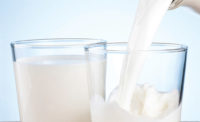As the world churns
East Coast snowstorms and the upcoming Super Bowl keep dairy processors busy
Transportation delays are anticipated to grow into cancellations as the snow storm further develops.

Butter is active, cheese is steady and milk processors pull out all the stops to get milk to retail, as a winter storm beats down on the East Coast. That’s a summary of USDA’s Dairy Market News for the week of Jan. 18 to 22. Read the full report here. Excerpts are below.
Foodservice accounts in the Central region demand for butter
BUTTER HIGHLIGHTS: Butter output is active in the country. Heavy cream volumes continue to clear into butter churns in all regions. Production is mostly focused on bulk butter. Some print butter is being made to meet immediate needs, however, a major part of the current production is moving into cold storage. In the Central region, demand from retailers is light, but steady from food service. In the West, some butter manufacturers note a decent domestic demand.
At this point, the butter market undertone is unsettled. Some buyers/ end users are skeptical about spot price volatility and are waiting for lower prices ahead of the spring holiday purchases. On the other hand, some buyers/end users are eager to get their retail butter needs met in advance of the spring holidays. This week, a cooperative export assistance program accepted requests for 1.543 million pounds of butter. At the CME Group, Grade AA butter price on Friday closed at $2.1700, down 8 cents from a week ago.
Cheese inventories are building in all regions of the United States
CHEESE HIGHLIGHTS: In the U.S., cheese production this week remains steady in the Northeast, but active in the Midwest and West. Readily available milk supplies are driving production volumes in the Midwest and West. In all regions cheese inventories are building, which is typical and expected in early Q1. Manufacturers in the West note small increases in cheese export activity and demand for barrels. The interest in barrels is welcome because supplies have been viewed as growing long.
Cheese pricing in the EU weakened with concerns over continuing milk volumes and cheese export challenges resulting from global production volumes. At the CME Group, Barrels closed the week on Friday at $1.4300, down $0.0950 from last week’s close and blocks closed at $1.4600, down $0.0350 from last week’s close.
Dairy processors prep for the Super Bowl, as sour-cream chip dip demand increases
FLUID MILK: Milk production is steady to increasing at seasonal levels across most of the country. However, marginal drops in output are reported in a few areas. Fluid milk sales vary across the regions. Bottling orders in the East are strong, as a wintery snow storm develops up and down the region. Milk transportation delays that are occurring are anticipated to grow into cancellations as the snow storm further develops. Sales into bottling moved lower in the Midwest as orders for specialty products declined.
Meanwhile, Arizona reports steady to lower fluid sales, as sales picked up in the Pacific Northwest. Cream is available across the regions, with the majority of interest coming from butter manufacturers. Supplies in the Midwest are being augmented by loads from the Northeast and West. With the Super Bowl fast approaching, interest in sour cream type products and dips continues to rise.
It’s a weak market for dry dairy ingredients
DRY PRODUCTS: Prices for low/medium heat nonfat dry milk are steady to lower, in a weak market. Output is heavy. Overall, demand is light. Buyer interest is growing around Q3/Q4 contracts. Dry buttermilk prices are mostly unchanged. Demand is limited, as supplies build. Dry whole milk prices are mixed in an unsettled market. Domestic demand is light. The export market is active. Dry whey prices are mixed. Production is at seasonal levels. Contracts that cover January and/or Q1 needs are keeping inventories in the Central region below year end levels.
Whey protein concentrate 34% prices are steady to higher. Demand is steady. Supplies are tight as a few plants shift to higher whey protein concentrations. Lactose prices are steady to higher, as the market firms. Interest is active in both the domestic and global markets. Casein prices are unchanged.
Looking for a reprint of this article?
From high-res PDFs to custom plaques, order your copy today!





